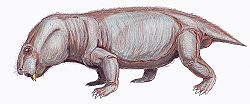| Idelesaurus Temporal range: Late Permian ~ | |
|---|---|
| Scientific classification | |
| Domain: | Eukaryota |
| Kingdom: | Animalia |
| Phylum: | Chordata |
| Clade: | Synapsida |
| Clade: | Therapsida |
| Suborder: | † Anomodontia |
| Clade: | † Dicynodontia |
| Clade: | † Cryptodontia |
| Genus: | † Idelesaurus Kurkin 2006 |
| Type species | |
| †I. tataricus Kurkin 2006 | |
Idelesaurus is a genus of dicynodont from the Late Permian (Wuchiapingian) Ilinskoe Subassemblage of the Sokolki Assemblage Zone of Russia. [1]





